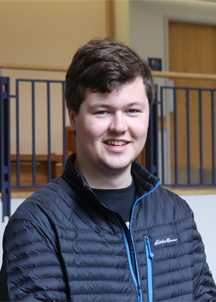Nathan Spear, Interdisciplinary Materials Science
*under the direction of Dr. Janet Macdonald & Dr. Richard Haglund
“Enhanced Plasmonic Upconversion in Coupled Metal-Semiconductor Nanoparticle Films”
12.06.22 | 11:00am CST | 132 Olin Hall
A large class of nonlinear materials show enhanced harmonic generation by exciting the localized surface plasmonic resonance (LSPR) of metallic or semiconducting nanoparticles. Moreover, material systems containing coupled plasmonic elements have been shown to increase performance beyond that of a single LSPR. This work describes a novel bilayer nanoparticle system in which plasmonic coupling occurs between the LSPRs of a metallic nanoparticle component (Au) and the second harmonic of the LSPR of a semiconducting nanoparticle component (CuS), under laser excitation at 1050 nm, the resonance fundamental of the CuS. These nanoparticles are processed into thin bilayer films whose upconversion order, absorption efficiency, and spectral profile were characterized. The effect of plasmonic interactions between CuS and Au nanoparticles on upconversion occurring via the mechanisms of second- and third- harmonic generation and multiple photon photoluminescence is explored. The critical importance of a harmonic relationship between the resonant frequencies of the two nanoparticles is demonstrated for both the fundamental and second harmonic resonance. An analytical model is also presented that describes the interactions between the CuS and Au as surface dipoles and predicts the observed upconversion enhancement reasonably well. The dependence of upconversion on the distance between the nanoparticles was also explored by adding interstitial layers of Al2O3 between the Au and CuS nanoparticle layers. Enhanced harmonic generation is proportional to the inverse sixth power of the interstitial layer thickness, consistent with the treatment of the coupling as occurring between surface dipoles. Finally, upconversion from Al nanoparticles, whose LSPR occurs at the third harmonic of the fundamental excitation wavelength, and the interaction of the Al with CuS and Au nanoparticles is examined. Understanding these processes opens a pathway to developing ultrafast, high efficiency upconversion thin film devices by clarifying the conditions that efficiently produce second- and third-harmonic generation without background multiphoton photoluminescence.
